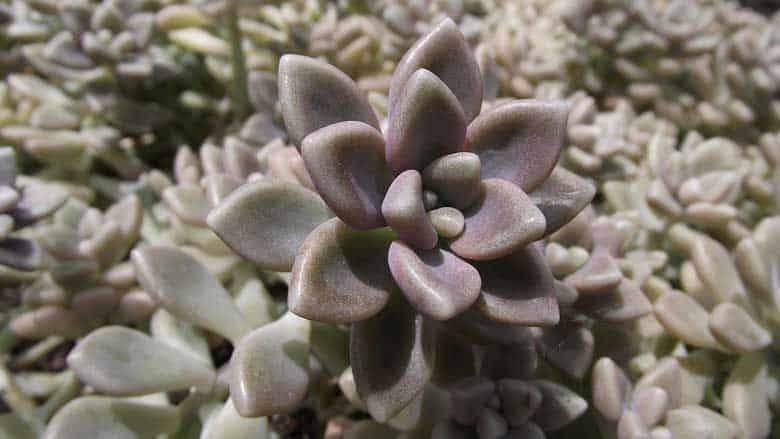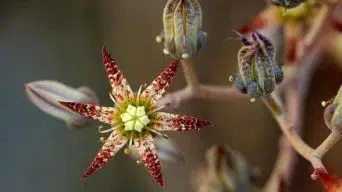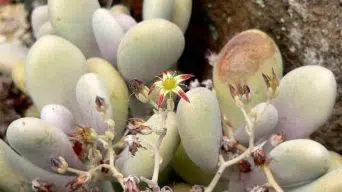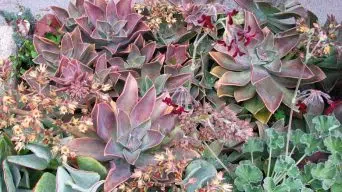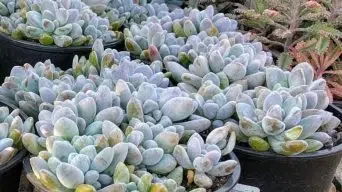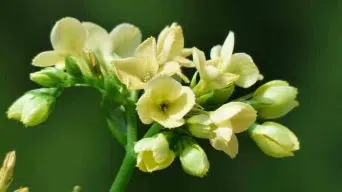Graptopetalum mendozae plants are a beautiful addition to any succulent collection.
These plants are fairly easy to care for, but they do require some specific conditions to thrive.
This complete guide will show you everything you need to know about Graptopetalum mendozae care and propagation.
Overview
Graptopetalum mendozae is a species in the genus Graptopetalum that belongs to the Crassulaceae family and is native to Mexico.
Graptopetalum mendozae is a small succulent plant that can grow up to 6 inches (15 cm) tall.
With erect to pendant or decumbent stems and rosettes of pale gray leaves, this plant has dark foliage in the summer months.
It also produces small white flowers with star-shaped petals!
How To Care for Graptopetalum Mendozae
Graptopetalum mendozae care will involve a few key factors:
The following are the things to consider for proper care of your Graptopetalum mendozae plant.
Sun Exposure & Light Requirements
The Graptopetalum mendozae plant is a succulent that will grow in full sun or partial shade.
It can tolerate part-day sun if it has enough water and protection from the harshness of the midday heat by being planted near an area with some tree cover.
Partial shade may be okay for potted plants. Still, Graptopetalums prefer to grow outside where they have plenty of access to sunshine all day long without any interruptions from other trees shading their foliage.
Most Graptopetalum species need six hours of sunlight per day at a minimum in order to thrive.
When your Graptopetalum is getting too much sun, you will notice that it tends to lose its lower leaves, which are exposed to direct sunlight. This can be remedied by moving them into a shadier location or giving them a bit of extra shade.
The Graptopetalum mendozae plant is considered an “easy” succulent because it does well with less than optimal care from its owners, but giving them proper sun exposure will result in more robust growth and healthier plants!
Watering Requirements
The Graptopetalum mendozae plants are classified as xerophytes, which means they thrive in dry conditions. However, this also means you should only water them sparingly and when the soil is extremely dry to avoid root rot from overwatering.
A good rule of thumb is to water your Graptopetalum plant when the top of the soil has completely dried out.
Another way to tell if it’s time for a drink is by feeling how heavy the container holding your Graptopetalums feels and monitoring the weight of that pot with dry and wet plants.
If you feel like there’s significantly less weight on one side or notice an increase in moisture accumulating at the bottom of your pot before watering again, then you know it’s time!
For most species, this will happen about once every two weeks during their growing season (spring and summer). However, other times may be necessary depending on specific circumstances, such as temperature variations. They should
A good rule to follow is to water less during the winter months and more in warmer weather.
Soil Requirements
The Graptopetalum mendozae plant prefers well-draining soil with ample room for roots to grow.
We recommend using a cactus potting mix, or you can also use your own blend of one part grit, two parts sand, and three parts peat moss with perlite mixed in until it feels moist when squeezed.
In the wild, Graptopetalum mendozae plants grow among rocks and need plenty of room for their roots to spread out.
If you replicate this environment in your home soil mix, add a layer of stones or gravel on top before adding potting mix.
Temperature and Humidity
Graptopetalum mendozae plants come from a desert environment.
This means they prefer daytime temperatures between 60 -80°F (16-27°C) and nighttime lows of about 50 to 65 degrees Fahrenheit.
They also require humidity below 50% to prevent the leaves from becoming sticky and wilting.
Fertilizing
Graptopetalum mendozae plants only need to be fertilized during the growing season, which is from March to September. During this time, you should fertilize your Graptopetalum mendozae plant every once with a water-soluble fertilizer.
The best time of the day for feeding Graptopetalums is in the morning, so the plants have all day and night to take up any nutrients they need from the fertilizer.
During the winter months, Graptopetalums do not need to be fertilized, so you should just let them rest and take care of themselves during this time.
Potting and Repotting
When repotting your Graptopetalum mendozae plant, it’s essential to avoid compressing its roots because they are delicate and can break easily if handled too roughly.
It’s better to work from below when you’re repotting a Graptopetalum mendozae succulent, so its root ball won’t get damaged while lifted out of the old container.
Most Graptopetalum mendozae plants will not need to be repotted more than once or twice a year, and you can quickly tell when your Graptopetalum needs repotting by looking for signs of roots coming out of the drainage holes in the bottom.
The Graptopetalum mendozae plant looks best when it’s given plenty of room in the pot, so you should consider repotting your Graptopetalum every time it outgrows its current container.
If you have a Graptopetauma mendozae that has outgrown its old container and is exhibiting signs of roots coming through drainage holes at the bottom, then it’s time to give your Graptopetalum some space with a new larger pot!
Pruning
Pruning Graptopetalum mendozae is not necessary. In general, you should prune your plant only if the following are true:
- You want to improve its appearance
- There’s dead or dying material on the plant that needs removing
- The size of the pot it has outgrown in a container garden space (i.e., more than two sizes taller)
If none of these things apply to your Graptopetalum mendozae, then there’s no need for any trimming!
Pests and Diseases
The Graptopetalum mendozae plant is susceptible to some common diseases and pests. These include spider mites, mealybugs, gray mold, or powdery mildew.
- Spider Mites. These pests are typically tiny, but they can be hard to spot, and it may take a few days before you notice the infestation. Spider mites suck sap from plants by piercing their leaves with tiny needle-like mouthparts.
- Mealybugs: These insects are covered in white waxy filaments that accumulate on the leaves and stems of your Graptopetalum mendozae plant. The mealybug will feed on your Graptopetalum’s foliage and bore into its stem or roots for food as well, making reproduction difficult, if not impossible, without treatment.
- Gray Mold: If left unchecked, this fungus will infect Graptopetalums, causing them to turn brownish-black and then die off altogether.
- Powdery Mildew: The Graptopetalum mendozae plant is also susceptible to this fungus. This sunburn-like disease has a powdery look and starts out yellowish, then turns brown over time.
How to Care for Graptopetalum Mendozae in Winter
If you live in an area that experiences cold winters, Graptopetalum mendozae succulents are generally not recommended for outdoor gardens because they don’t tolerate frost well.
However, if your climate stays mild, you can overwinter Graptopetalum mendozae succulents in a pot indoors or outdoors.
For Graptopetalum plants that are indoors or planted outside for the winter season, make sure they get enough light by placing them near south-facing windows on your property or in a location that gets sunlight for at least six hours each day.
Graptopetalum mendozae plants need a period of rest from watering during the winter months to ensure they don’t rot or die off due to lack of moisture. Do not overwater your Graptopetalums while they’re resting!
For Graptopetalum mendozae plants planted outside during the winter, you may need to monitor water levels and provide extra protection from extreme cold weather with mulch or other materials.
How To Propagate Graptopetalum Mendozae
The Graptopetalum mendozae can be propagated by leaf cuttings, offsets, and seeds.
Leaf Cuttings
When propagating your succulents, start by getting a healthy leaf from the mother plant.
You want to be careful that no part of it is still on its stem; this will ensure the propagation works!
Before planting in soil, wait for a few days to callous and heal over before replanting.
Use well-draining soil when ready for new roots – don’t forget to water often enough if/when moisture dries below ground level!
Offsets
When your Graptopetalum mendozae starts to grow offsets, you can also use them for propagation purposes.
The way it’s done is by removing the offset from a mother plant and allowing it to callous for a few days before planting.
The offset will grow roots independently, and you can pot or plant them directly into the ground.
This is an excellent way to make sure your Graptopetalum mendozae stays healthy without sacrificing any parts of it!
Make sure that you’re keeping up with watering as well; this may mean more regular watering than usual if/when moisture dries out below ground level.
Seeds
You can also use seeds to propagate your Graptopetalum mendozae, but it may take longer than the other methods.
It’s not hard, though; you need a clean soil mix and some patience!
First of all, plant your Graptopetalum seed in moist potting soil and place it in an area that gets filtered sunlight.
Water your pot daily and ensure it drains well so the soil stays moist but not soggy – if you let it dry out completely, all of your work will have been for naught!
The Graptopetalum mendozae should start to sprout in a few weeks or months, and you can then carefully transplant it into a container that’s bigger and better suited for the full-grown plant.
Once your Graptopetalum starts growing, water it enough – this may mean more regular watering than usual if/when moisture dries below ground level.
The Graptopetalum mendozae succulents will need a good soil mix with plenty of drainage holes and light.
Is the Graptopetalum Mendozae Toxic?
The Graptopetalum mendozae plant is not toxic to humans or animals.
The Graptopetalum plant may cause irritation to sensitive skin or eyes, so make sure you wash your hands after touching it, and that small children stay away from the leaves of a Graptopetalum mendozae.
You should be careful when handling this succulent because the sap might irritate your skin.
Final Thoughts
Graptopetalum mendozae succulent plants are great for beginners or those with a green thumb and are worth the minimal effort they need to be happy.
They can tolerate some neglect, but not too much.
The Graptopetalum mendozae plant is such an interesting-looking succulent that it would make any space feel more homey, even without adding other plants.

